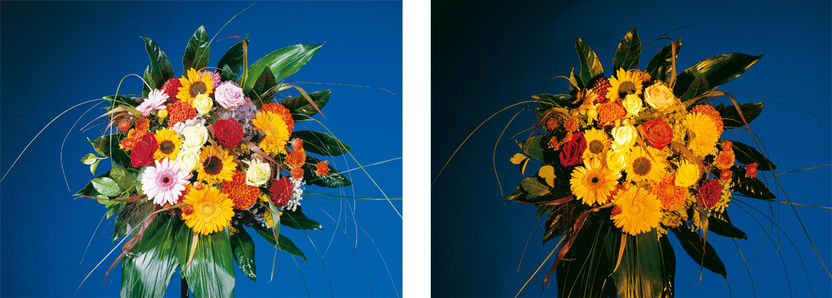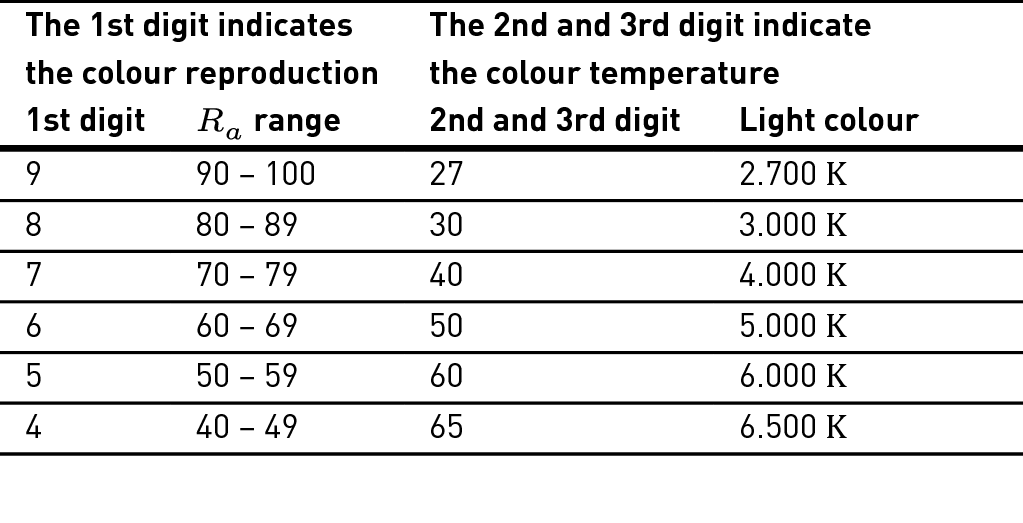For visual performance, comfort and well-being, it is important that the colours of the surroundings, objects and human skin are rendered naturally and realistically. This makes people appear attractive and healthy. According to location and visual tasks, artificial illuminants should ensure a correct colour perception as similar as possible to natural daylight.
Colour rendering
In spite of identical light colours, illuminants can have varying colour rendering characteristics due to different spectral compositions in their radiation. The general colour rendering index Ra was introduced to ensure an objective labelling of colour rendering properties. The colour rendering index represents the measure of correspondence of the seen body colour and its appearance under the respective reference light source. To determine the value of Ra, colour variations from 8 standardised test colours occurring when the test colours are illuminated using the light source to be evaluated/the reference light source are identified. The smaller the variation, the better the colour rendering characteristic of the tested light source. A light source with Ra = 100 renders all colours ideally as under the reference light source. The lower the value of Ra, the lower the quality of the colour rendition. For colour temperatures up to 5.000 K the reference light source is a black body radiator (see below). For higher colour temperatures the reference light source is a standardised daylight spectrum at 6.500 K.

Table 3.11: Areas for the general colour rendering index Ra of lamps
*) No longer sold due to ErP Directive (also, c.f. Chapter )

Figure 3.29: Good colour rendering and insufficient colour rendering.
Illuminants with a colour rendering index below 80 should not be used in indoor rooms where people work or linger over extended periods of time (more than 2 hours) according to EN 12464-1 (see chapter , "Rules and standards"). The norm permits exceptions for particular lighting tasks, for example when economic reasons require lamps with high luminous efficacy, e.g. high-pressure sodium vapour lamps, which feature limited colour rendering. This applies e.g. for the lighting in high halls. However, in such cases, suitable measures must be taken to ensure higher colour rendering at steady and permanently occupied workstations as well as in areas where safety colours must be recognised without error (see also ISO 3864 "Graphical symbols – Safety colours and safety signs – Part 1: Design principles for safety signs in workplaces and public areas").
In practice, this issue can be considered obsolete nowadays, due to the advanced development of efficient LED luminaires. With a high luminous efficacy of ≥ 130 lm/W and good colour rendering (Ra ≥ 80), LED luminaires can also be used to implement economically sound lighting solutions in industrial manufacturing plants at affordable cost.

Table 3.12: International, non-proprietary colour label for light sources
In order to label light colour and colour rendering of illuminants, a non-proprietary colour label consisting of three digits was introduced internationally (see table). For example, the label 840 declares a colour rendering index between 80 and 89 as well as the colour temperature 4.000 K, which corresponds to the light colour neutral white. For conventional lamp types, there frequently are specific name affixes for colour rendering properties (see table). For LED luminaires, the international labelling system has mostly prevailed.
In contrast to conventional illuminants, high-quality LED luminaires with good or excellent colour rendering can be provided at a minimal loss of luminous efficacy.